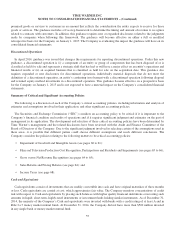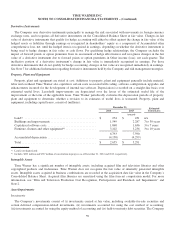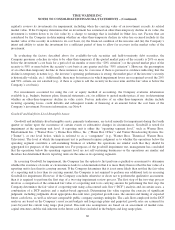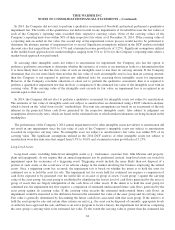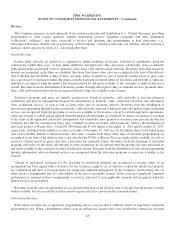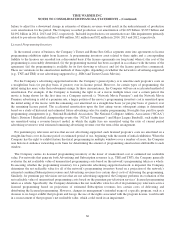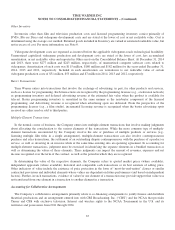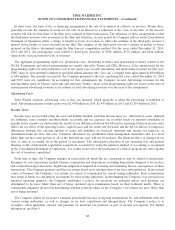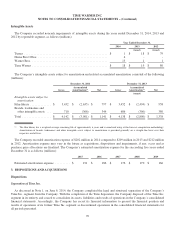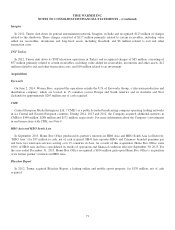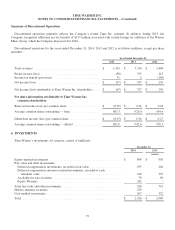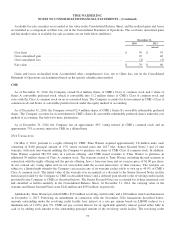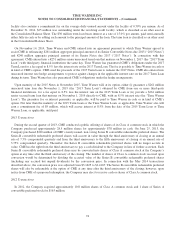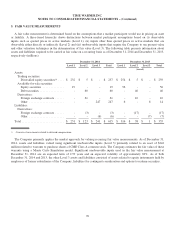Time Magazine 2014 Annual Report Download - page 83
Download and view the complete annual report
Please find page 83 of the 2014 Time Magazine annual report below. You can navigate through the pages in the report by either clicking on the pages listed below, or by using the keyword search tool below to find specific information within the annual report.TIME WARNER INC.
NOTES TO CONSOLIDATED FINANCIAL STATEMENTS – (Continued)
Other Inventory
Inventories other than film and television production costs and licensed programming inventory consist primarily of
DVDs, Blu-ray Discs and videogame development costs and are stated at the lower of cost or net realizable value. Cost is
determined using the average cost method. Returned goods included in Inventory are valued at estimated realizable value, but
not in excess of cost. For more information, see Note 6.
Videogame development costs are expensed as incurred before the applicable videogames reach technological feasibility.
Unamortized capitalized videogame production and development costs are stated at the lower of cost, less accumulated
amortization, or net realizable value and reported in Other assets on the Consolidated Balance Sheet. At December 31, 2014
and 2013, there were $277 million and $243 million, respectively, of unamortized computer software costs related to
videogames. Amortization of such costs was $115 million, $180 million and $182 million for the years ended December 31,
2014, 2013 and 2012, respectively. Included in such amortization are writedowns to net realizable value of certain
videogame production costs of $51 million, $53 million and $7 million in 2014, 2013 and 2012, respectively.
Barter Transactions
Time Warner enters into transactions that involve the exchange of advertising, in part, for other products and services,
such as a license for programming. Such transactions are recognized by the programming licensee (e.g., a television network)
as programming inventory and deferred advertising revenue at the estimated fair value when the product is available for
telecast. Barter programming inventory is amortized in the same manner as the non-barter component of the licensed
programming, and Advertising revenue is recognized when advertising spots are delivered. From the perspective of the
programming licensor (e.g., a film studio), incremental licensing revenue is recognized when the barter advertising spots
received are either used or sold to third parties.
Multiple-Element Transactions
In the normal course of business, the Company enters into multiple-element transactions that involve making judgments
about allocating the consideration to the various elements of the transactions. While the more common type of multiple-
element transactions encountered by the Company involve the sale or purchase of multiple products or services (e.g.,
licensing multiple film titles in a single arrangement), multiple-element transactions can also involve contemporaneous
purchase and sales transactions, the settlement of an outstanding dispute contemporaneous with the purchase of a product or
service, as well as investing in an investee while at the same time entering into an operating agreement. In accounting for
multiple-element transactions, judgment must be exercised in identifying the separate elements in a bundled transaction as
well as determining the values of these elements. These judgments can impact the amount of revenues, expenses and net
income recognized over the term of the contract, as well as the period in which they are recognized.
In determining the value of the respective elements, the Company refers to quoted market prices (where available),
independent appraisals (where available), historical and comparable cash transactions or its best estimate of selling price.
Other indicators of value include the existence of price protection in the form of “most-favored-nation” clauses or similar
contractual provisions and individual elements whose values are dependent on future performance (and based on independent
factors). Further, in such transactions, evidence of value for one element of a transaction may provide support that value was
not transferred from one element in a transaction to another element in a transaction.
Accounting for Collaborative Arrangements
The Company’s collaborative arrangements primarily relate to co-financing arrangements to jointly finance and distribute
theatrical productions and an arrangement entered into with CBS Broadcasting, Inc. (“CBS”) and the NCAA that provides
Turner and CBS with exclusive television, Internet and wireless rights to the NCAA Tournament in the U.S. and its
territories and possessions from 2011 through 2024.
67


